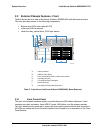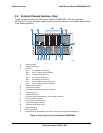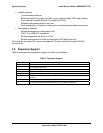
System Overview Intel® Server Platform SR6850HW4 TPS
Revision 1.0
Intel order number D23151-001
16
2.5.12 Cooling Subsystem
Primary cooling is generated by six fans, located at the top front of the chassis. It connects
to the SCSI Backplane Board for power and server management. Air flows in through the
front and exhausts out the rear of the chassis. The chassis has several air baffles to duct the
air over critical parts, including processors, memory, and peripherals. Processor heat sinks
or processor heat sink blanks, and Memory Boards or Memory Board blanks must be
installed in each corresponding area to ensure proper airflow.
The system fans are sized to provide cooling for a fully configured system. The cooling
system is designed using a worst-case analysis and appropriate fan speeds were chosen to
meet acoustic and thermal requirements. Server management controls fan speed based on
ambient and component temperatures. To ensure proper cooling, failed fans should be
replaced within 1 minute.
2.6 New Platform Features
2.6.1 Advanced Memory Performance and Protection
The Server Board Set SE8500HW4 supports several new memory features that allow
flexibility in performance, redundancy and the ability to upgrade. The System BIOS can be
configured as follows:
Maximum performance, where memory is up to four-way interleaved
Maximum compatibility, where memory can be hot-added
Memory mirroring, where two or four boards are used to keep a copy of system
memory
Memory RAID, where four boards are used in a RAID4-like mode
Memory sparing, where a portion of each Memory Board is reserved for failover.
Hot-replace means the user can replace a Memory Board with another Memory Board of
identical total size. This operation is supported in maximum compatibility, memory RAID and
memory mirroring modes.
Hot-add means the user can add a Memory Board to a previously unoccupied slot. This
requires operating system support and is supported in memory compatibility and memory
mirroring modes.
Hot-removal means the user can remove a Memory Board. This operation is supported in
memory RAID and memory mirroring modes.
Hot upgrade means the user can replace an existing Memory Board with a Memory Board
that contains more memory capacity. A hot upgrade is not a unique operation, it is
implemented as a hot-remove followed by a hot-add. This requires operating system support
and is supported by the memory RAID mode only.
See the Intel Server Board Set SE8500HW4 Technical Product Specification for more
details on these new features.


















